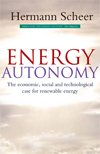 Article published with Jane Taylor, March 2006
Article published with Jane Taylor, March 2006 An answer to James Lovelock
It is a well known experience, that even a high sophisticated scientists views about dangers don’t have adequate answers how to avoid it. So it is a very actual problem, that many protagonists who warn about the running climate catastrophe fail miserably in giving an adequate answer how to fight it. This leads to disastrous socio psychological consequences: people, mainly the young, are left alone with these dangers and don’t believe any more that there could be a solution. This creates no-future mentalities and, as the Californian sociologist Robert N. Bellah wrote in “Habits of the heart”, destroys the social ecology before the destruction of the ecology of nature happens.
James Lovelock, the famous nature ecologists, is an example of this delicate discrepancy. His actual definition of atomic energies as a “green energy”, his call for a broad and worldwide mobilization of atomic reactors as the only solution for mitigating the climate catastrophe derives from a total underestimation and misunderstanding of renewable energies. Deeply concerned about the ever increasing fossil fuel consumptions instead of introducing radical strategies for replacing fossil fuel dependencies he jumps on the side of the atomic community. But his call betrays an intellectual capitulation. Probably he never took a serious look to the real natural, technological and economic potential of Renewable Energies. For Lovelock there would be “no chance that the renewables, wind, tide and water power can provide enough energy and in time.”What about the real facts? 436 atomic power reactors are still working globally. Only for meeting the indispensable goal of the Intergovernmental Panel on Climate Change (IPCC) for reducing global greenhouse gas emissions to a level of 40 percent up to 2050 with such reactors, there would be the need of 2500 additional 1000 MW atomic reactors. That would mean: each week a new reactor in the run of the next fifty years! And what about the inherent dangers of atomic weapons proliferation by such a development? From where should come the tremendous amount of water for their steam and cooling processes, in the same time of a running water crisis in more and more countries? And what about the emergency capacities for atomic accidents and the atomic waste management for thousands of years? Or about the global warming effect because of the increasing atomic powered heat production? Not more than 5 % of the world’s energy supply is actually met by atoms, based on public subsidies of more than 1 trillion Dollars since the 50ies! It is totally unrealistic to find a solution with the atomic option.
On the other side: Serious scientific scenarios were presented since the 70ies for the achievement of a total renewable energy supply up to the year 2050. The most famous was introduced in 1978 by the Union of Concerned Scientists in the United States, supported by President Carter, based on a comprehensive view to all renewable energy options, including biomass, solar thermal energy, photovoltaic solar energy conversion, small hydropower and the huge geothermal energy potential – all not mentioned by Lovelock. All these scenarios – one of them for Germany, presented by the Parliaments Inquiry Committee in 2002 – are ignored by the conventional energy experts.
All the scenarios indicate that this would lead, after an initial period, finally to lower energy prices than must be paid for conventional energies. Two reasons allow this forecast. All costs for Renewables, with the exemption of Biomass, are only costs for technologies, not any more for fuels. That means: Renewable costs will go down with its technological improvements and mass production. In contrast to that fossil and atomic energy costs will go up, because the reserves are running out in the next decades. The uranium resources for the present atomic power reactors will be finished in roughly 40 years. Any continuation of atomic energy production requires much higher additional costs for reprocessing facilities, fast breeder reactors or, if it ever could work, for atomic fusion reactors. The second reasons: atomic energy supply requires long energy chains, that means tremendous additional investments for infrastructure, mainly long new high-voltage transmission lines. Renewable energies can be mostly supplied with short energy chains, and many of its options could be used off-grid.
Renewables are indigenous energies everywhere, and create many new economic incentives: for a revitalization of agriculture by the mobilization of Biomass for Energy, for new energy conversion industries and for the whole building construction sector towards the future of solar buildings. It inspires the people, the more become aware of the real possibilities to use renewable energies in their own responsibility. Today the energy consumers are a part of the problem. As renewable energy consumers they will become an active part of the solution.
The most central point of Lovelocks theory simply is a myth. The introduction of Renewables, he argues, would last too long. That is only true as long as the manifold artificial barriers are not set-aside. It is a matter of fact that no energy technology can be installed faster than the technology for Renewables and that no construction time is longer than that for atomic power stations which is ten years and more. A windmill is installed within one week. In Germany we installed in the last four years, based on our Renewable Energy Act from 2000, 10.000 MW new wind-power capacities. If there would have been in 2000 the decision for the equivalent of five new atomic power stations, each of 1000 MW capacity, not one could start to work before 2010.



